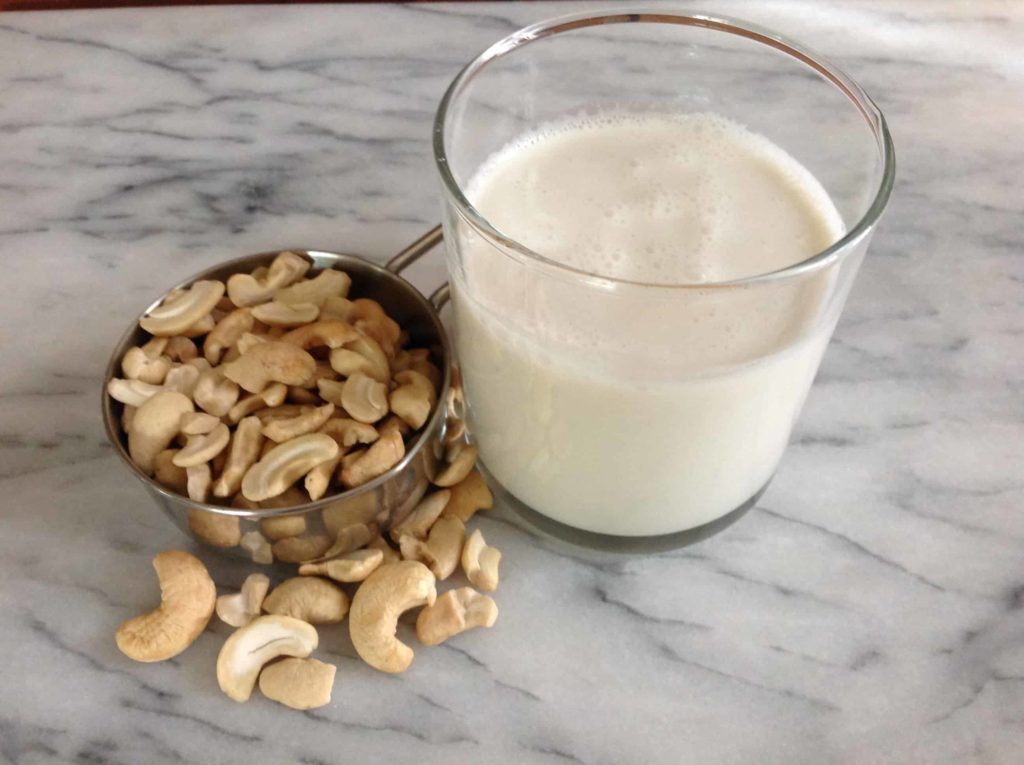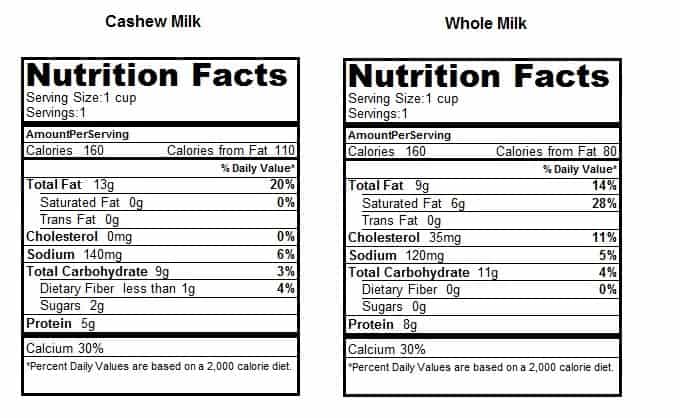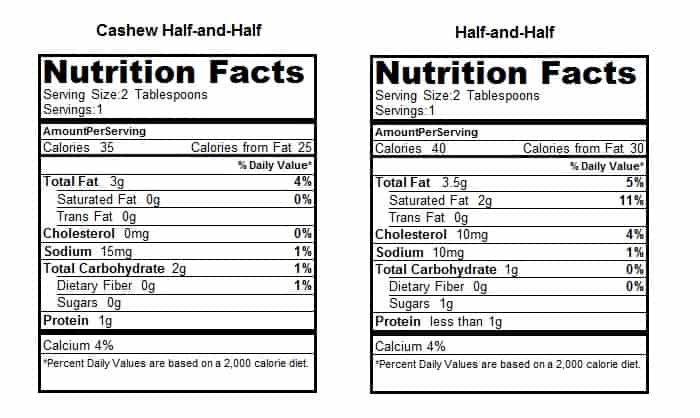
In the ever expanding category of nondairy milk, cashew milk has become a favorite. Although soymilk is a closer match for cow’s milk in terms of protein, it does have that distinctive beany flavor. (Which I don’t find unpleasant…just pronounced.)
Cashew milk, on the other hand, has a much milder flavor. To my palate, at least, it is the most dairy-like in taste and mouth feel. It’s also–by far–the easiest nondairy milk to make yourself, which can save you big bucks. You can even add your own calcium and vitamin D!
How to Make Cashew Milk
IMPORTANT NOTE: A small number of food-poisoning episodes have been linked to homemade nut milks. If you choose to soak your nuts, be sure to keep them refrigerated throughout. (Pathogens can multiply at room temperature.) Make sure to wash hands and sanitize any utensils.
- 1/2 cup raw, unsalted cashews
- 2 cups cold water
- pinch salt (optional)
Combine the ingredients in a high-powered blender, such as a Nutribullet or Vitamix, and blend on the highest speed for about 30 seconds. Makes about 2 1/2 cups.
The result is roughly equivalent to whole milk in calories and consistency, albeit a bit lower in protein and higher in fat. Add 1/2 teaspoon of calcium carbonate powder (such as this one) per batch, it’ll provide the same amount of calcium as cow’s milk. You could also add a drop or two of liquid Vitamin D3. (Here’s a vegan option for liquid Vitamin D).
Reduced Fat Cashew Milk
Increasing the water to 3 cups will give you something closer to 2% milk in terms of calories and consistency, but even lower in protein and higher in fat, compared with cow’s milk.

Cashew Half and Half!
And here’s the most fun of all: Decrease the water to 1 cup and you’ll get something akin to half-and-half–except, the protein is higher and fat is lower compared to the dairy product! (Equal parts cashews and water will produce something the texture of whipped cream.)

Additional Tips:
- Save money by buying raw cashews in bulk. Save even more by buying halves and pieces rather than whole cashews. You’re just going to grind them up!
- You can soak the cashews for 30-60 minutes and drain before blending if you like but if you’re short on time, you can just throw them in dry.

Thank you very much for this article on how to make cashew milk. I will try this one . I just want to ask its shelf life, and how I can prolong the shelf life of cashew milk? Hope to hear fron you soon. Thank you very much and may God bless you more!!
The cashew milk will keep for a week. But the dry cashews will keep for months so I’d recommend making blending up as much as you need for a week at a time.
I read something recently suggesting that cashews contain signigicant leptins, which can interfere with microbiota. For beans and lentils, the suggestion to reduce leptins was to soak them and then thoroughly cook them. Would this be a reason to soak the cashews if making cashew milk?
I think you mean lectins, not leptins.
To the extent that lectins are a real concern (I’m not convinced that they are), soaking the cashews would reduce the lectin content.
What are lectins and why are they bad for you. I give my one homemade cashew milk and wasn’t aware of this. Also, wouldn’t you completely destroy or at least lessen the nutritional content by cooking them after soaking?
Lectins are naturally occurring compounds in nuts, seeds, and grains that can bind to minerals and lessen their absorption. In my opinion, this does not present a significant issue for most people. You can soak the cashews before blending but I do not recommend cooking the cashews or the cashew milk.
Here are a couple of articles on lectins and the effect of cooking on nutrition that you may find useful (ad blocker recommended)
https://www.quickanddirtytips.com/health-fitness/healthy-eating/lectins-and-the-plant-paradox
https://www.quickanddirtytips.com/health-fitness/healthy-eating/how-cooking-affects-nutrients
Thank you SO MUCH for this very informative text. It’s exactly what I was searching for!
I’m thrilled to find this recipe for Calcium-enriched Cashew Milk. I’m 82, have advanced osteoporosis, no pain or disability, a tad bit of scoliosis in recent years, and am in heart failure, on metoprolol (for heart arrhythmia, blood pressure is fine), and Eliquis (post blood clots after a heart ablation 15? years ago. What kind of CALCIUM would be least likely to “go directly to my blood vessel lining” but would instead go mostly to my porous bones? And do I need to take VIT. K2 to send the calcium to bone, not to vessels? How much daily? I’ll run your answers past my doctors, so you’re safe.
The form of calcium (whether carbonate, citrate, or whatever) is not as important as the amount (that is, not overdoing it) and the presence of other nutrients including vitamin K, D, magnesium, etc. Recent research also indicates that diets high in fiber help to protect bone health through the beneficial impact on the microbiome.
A diet that contains lots of vegetables (especially those from the cabbage family) will provide calcium, magnesium, vitamin K, fiber, and other bone-building nutrients that help to direct calcium to the bones and not to the arteries.
One advantage of adding calcium to milk substitutes rather than taking high dose supplements is that the nutrient is likely to be consumed in smaller amounts, more frequently throughout the day. It’s also consumed with other foods and nutrients, which helps boost absorption.
Here are a few more resources to explore:
Diet for Healthy Bones
Best Sources of Calcium
Vitamin K and Natto
Would this be an appropriate plant-based alternative to whole milk for babies being weaned off of breastmilk or formula at 12 months?
For those who avoid animal products, the liquid Vitamin D3 linked in this article is made from lanolin, a wax secreted by the sebaceous glands of wool-bearing animals. Plant-based alternatives include Plant-D3 Organic Vitamin D3 5000 IU, Nordic Naturals Plant-Based Vitamin D3 Liquid 1000 IU, Pure Therapro Rx Vegan D3 + K2 Organic Full Spectrum Liquid for Maximum Absorption , Peak Performance USDA Organic Vegan Liquid Vitamin D3 with K2 Drops, among others.
Unflavored vegan calcium supplements made from red algae, some of which also contain vegan D3 are also available.
Thanks for that input, Rebecca. I’ve added a link to a vegan vitamin D2 option.
Thanks for this article! I often hear that taking calcium supplements is not great for artery health. But fortified products are recommended. Is there really a difference? Is the powder better as it’s a lower dosage at time of consumption?
Yes, with fortified foods, you’re generally getting the calcium in smaller amounts and combined with other nutrients from the foods which might aid in absorption. But there’s still no need to overdo it. Supplements and/or fortified foods should only be used to close the gap between the recommended intake and what you’re already getting from the (unfortified) foods in your diet.
Same for almond milk?
No, the process and proportions described above will not necessarily work for almond milk–and the nutritional composition will be different as well. But if you have a recipe/process for making homemade almond milk, you can add calcium and/or vitamin D to it!
If one strains the cashew milk though a cheese cloth, is there any way to know what the calories/macros would be in that case?
Short of sending the residue or the milk itself out for nutritional analysis, I don’t think it is possible to estimate this. But if you have a good quality blender, the cashews should blend completely into the liquid and there should be a little to nothing to strain out. That is one of the advantages of using cashews instead of other nuts.